I trekked to Everest base camp here are 14 things I packed for the almost 2-week trip to stay warm and hydrated with the rising altitude

- I recently went on a two-week trek to Everest base camp with my dad and aunt.
- I fit everything into a backpack and duffel bag, and planned carefully for cold and rainy weather.
In September, I went on a two-week trek to Everest base camp in Nepal, which sits at an altitude of 17,598 feet.
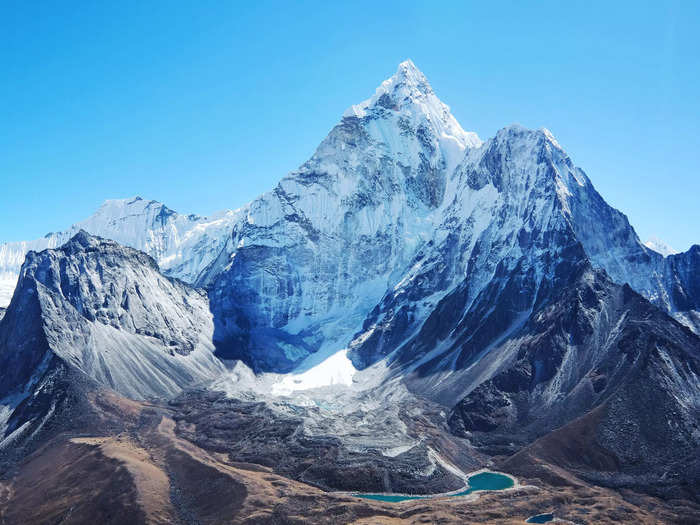
I've spent most of my summers hiking in the Pacific Northwest near my home in Seattle, and hiked almost 100 miles along the West Highland Way in Scotland three years ago, but I'd never gone on a trek with such a major elevation gain as Everest. Luckily, I was joined on the trip by my dad and aunt, who'd both trekked to the base camp of K2, the world's second highest mountain only to Everest, in 2018.
The trek up to Everest base camp from the starting point in the city of Kathmandu takes nine days. This includes two rest and acclimatization days where you hike to around 3,000 feet to train your body to adjust to the elevation gain, and seven days of trekking for five to eight hours a day. Each night, we stayed indoors in tea houses along the trail, which are modest accommodations offering cots, a hot meal, showers, and electricity to charge your devices.
Although we'd planned to trek down afterwards, which typically takes three days, we only did one way of trekking to a lower base camp and then took a helicopter to return to Kathmandu because of an impending storm in the Himalayas.
Since my aunt and dad had more trekking experience than me and had learned a few do's and don'ts in the process, I followed their tips on what to pack.
When packing for a trek to Everest base camp, it's important to consider the weather, rising altitude, and weight limits on the luggage you can bring.
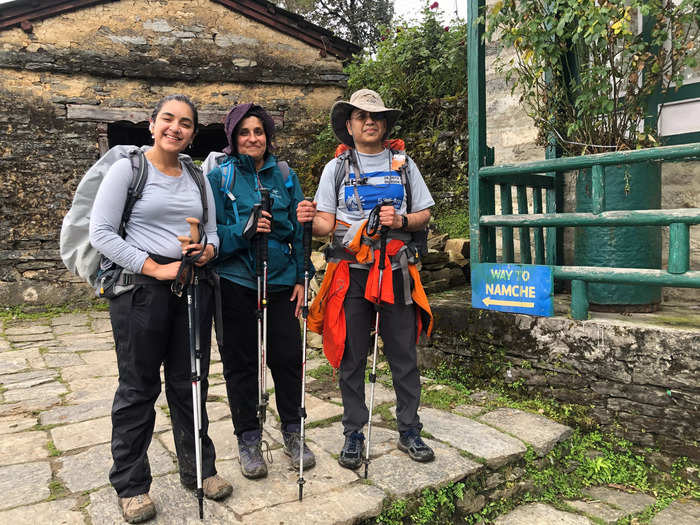
We did our trek with Himalayan Wonders, which provided a trek guide as well as porters who carried our duffel bags between the tea houses where we stayed overnight along the way.
On our trek, we were allowed to bring a 10-pound daypack, which we carried with us on day-to-day trekking, and a 22-pound duffel bag. We knew the weather in the Himalayas could be unpredictable, and that it was important to prepare for rain with lightweight layers and waterproof gear.
For long days of trekking, durable waterproof hiking boots were a must.
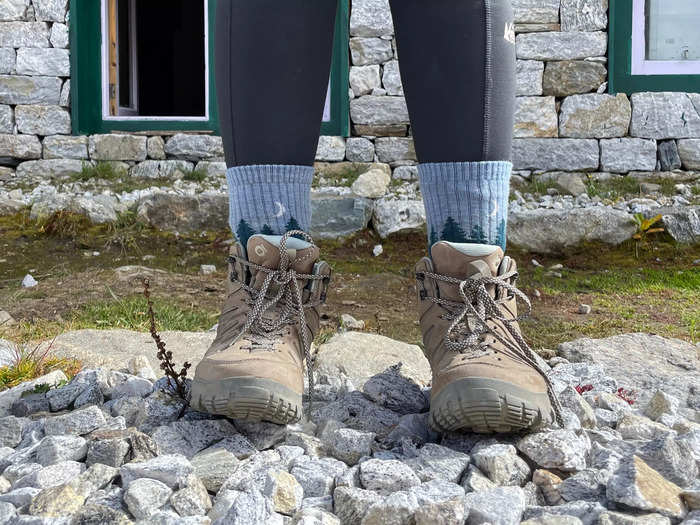
As someone who hikes every summer in the Pacific Northwest, I've tried a lot of hiking boots. For this trip, I knew I needed to invest in a well-fitted, waterproof hiking boot with ankle support to minimize the risk of falling while navigating rocky terrain and hills in the Himalayas.
I chose the Sawtooth X Mid Waterproof Hiking Boots from Oboz, which cost $165. They were sturdy and kept my feet protected, and I was pleased to notice that they dried quickly even after wading through puddles and mud. Although hiking boots can be pricey, I think these are worth the investment as a regular hiker — footwear issues were the last thing I wanted to deal with on a two-week trek.
I made sure to try on my new boots at an REI store with thick socks before deciding on the size, and followed the clerk's recommendation to go a half-size up from my typical shoe size to allow for more wiggle room.
Retractable hiking poles helped me find and keep my footing on the trails.
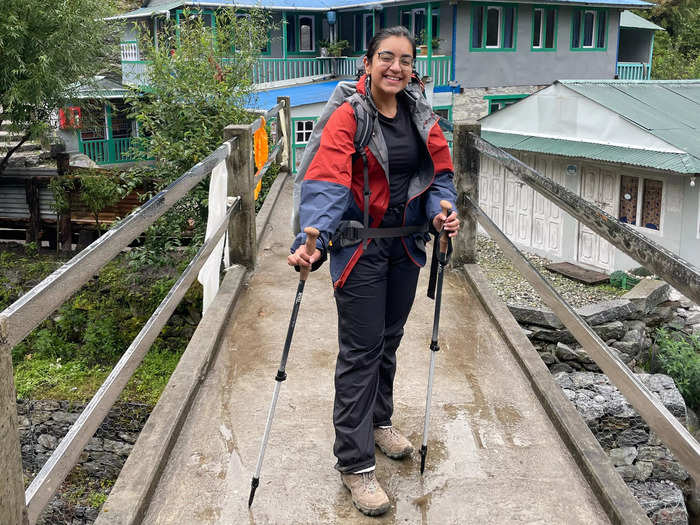
Despite being an avid hiker, I'm still prone to clumsiness on trails. On this trek, I benefited from having retractable hiking poles, which my aunt and dad recommended from their experience hiking K2.
Having hiking poles helped me find my footing during rocky and steep portions of the hike, especially when paths were narrow. Plus, they were easy to collapse and attach to my backpack when I wasn't using them. If you don't have room in your suitcase to bring your own poles, I recommend buying some at the shops in Kathmandu and donating them to future trekkers after the trip.
Merino wool tops were my staple base layer for each day of trekking.
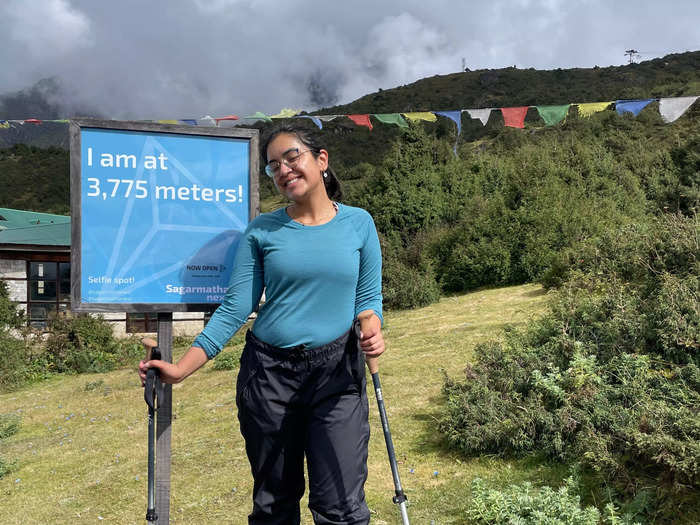
The best way to stay warm is to layer, so I brought several long-sleeve, merino wool tops that kept me warm and comfortable during long days of hiking. I'd bought a few of these shirts when I trekked through the Scottish Highlands three years ago, as they were highly recommended by other seasoned hikers because merino wool is a breathable material that still keeps you warm.
I rotated between a few of these shirts and wore them two to three times each, since we only had access to laundry early on in the trek. Because the shirts are so lightweight, I was also able to dedicate more space in my duffel to additional jackets and layers.
I relied on Alcala deodorizing wipes and baby wipes to stay fresh.
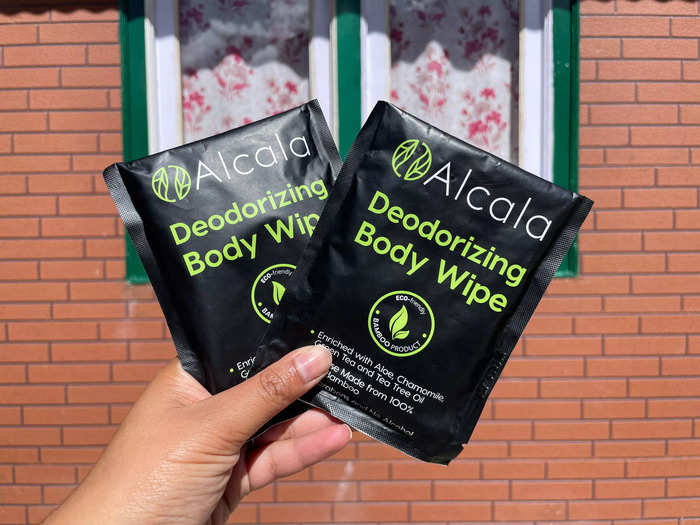
On this trek, we stayed at indoor tea houses every night, where we were reunited with our duffel bags, ate a hot meal, and had time to refresh before the next day. While many of the tea houses offered hot showers, we knew they'd be pricey and less common as we got higher in altitude because it's expensive to transport materials up the Himalayas, so we didn't count on being able to shower in the latter days of the trek.
I used these deodorizing body wipes each night after hiking, which helped me feel refreshed before bed. I'm planning to keep these in my daypack for future hikes, and also I think they're great to pack for camping or multi-day backpacking.
I also brought a 60-pack of baby wipes in my day pack, which I used to clean my hands or use the restroom, since toilet paper was rarely available along the trek or in the communal restrooms in the tea houses. I also used a multi-purpose soap wash, the Sea to Summit Wilderness Wash, for soap, shampoo, and laundry detergent. It's very concentrated, so I was able to share the 1-ounce bottle with my family and still had plenty left over.
Sock liners and Darn Tough socks got me through long days of trekking.
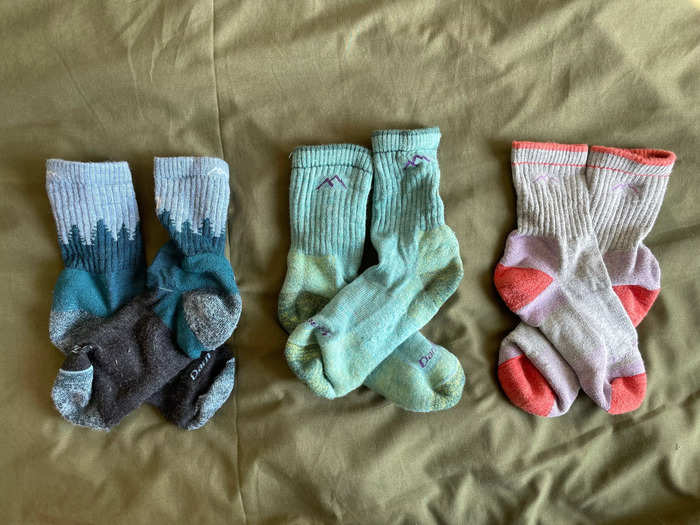
To ensure that I could get the most use out of my heavier Darn Tough hiking socks, I also bought these liner socks that I changed daily. This combo helped protect my feet in the cold and snow, and I liked that the Darn Tough socks added a little pop of color to my otherwise monochrome outfits.
In addition to having good socks, I also used medical tape to help avoid blisters, and kept blister bandages in a variety of sizes on hand just in case. Thankfully, the medical tape prevented blisters so I didn't have to use any bandages.
I took a fleece zip-up that I could put on and take off depending on the temperature.
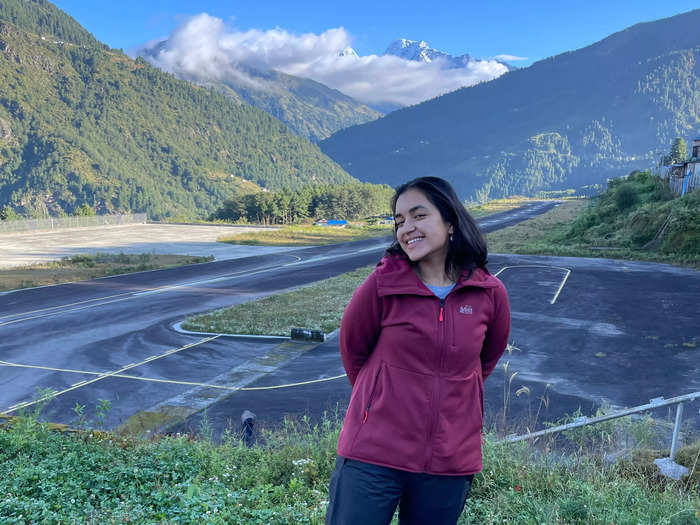
While trekking, my body temperature could go from warm to shivering depending on the altitude and terrain, so I always kept this fleece zip-up jacket on me. By layering the jacket over a merino base layer and with a waterproof jacket on top, I was ready for any weather.
The jacket has convenient zippered pockets where I kept my phone, headphones, and hand sanitizer within reach while trekking. I also wore this zip-up in the tea houses since they usually weren't heated.
A portable battery was essential for keeping my phone charged.
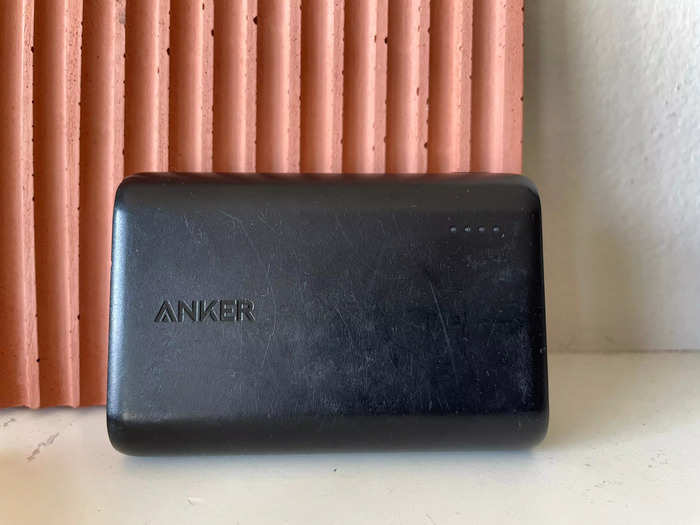
Most tea houses will charge your phone or battery pack for a fee, which goes up as you reach higher elevations, so I relied on a portable battery pack to charge my phone, Apple Watch, and Bluetooth headphones. It lasted me a few days on each charge, and I had to spend less money individually charging each of my devices.
I appreciated the handsfree nature of my Bluetooth headphones to listen to my favorite podcasts with ease, but I wish I'd brought wired headphones as a backup pair that I wouldn't have had to worry about charging.
I brought a lightweight pair of gloves to keep my hands warm as the temperature dropped.
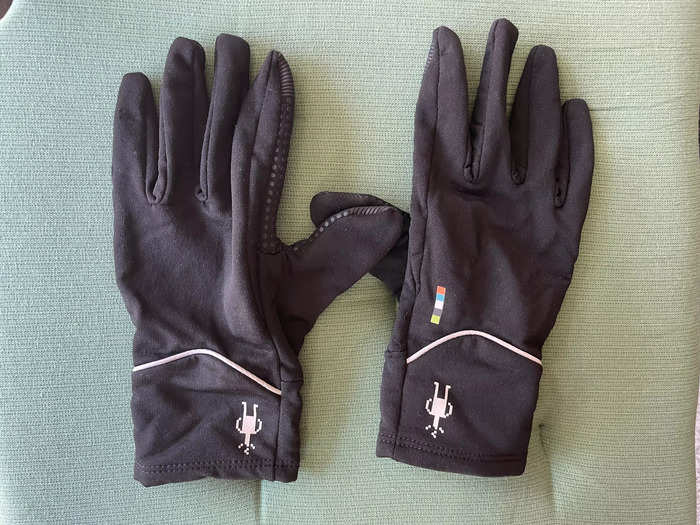
While hiking I wore a lightweight pair of merino gloves made of a soft, brushed fabric with silicone grips. They kept my hands warm, and the grips also helped me keep a better grasp on my hiking poles. They're also touchscreen friendly and were easy to fit in my pocket when I wasn't using them.
Although these were more expensive than the gloves I usually buy from Target, they held up great during the trek and I think they'll last for quite a while — I plan to use them this winter in Seattle.
Having waterproof gear gave me peace of mind when it rained.
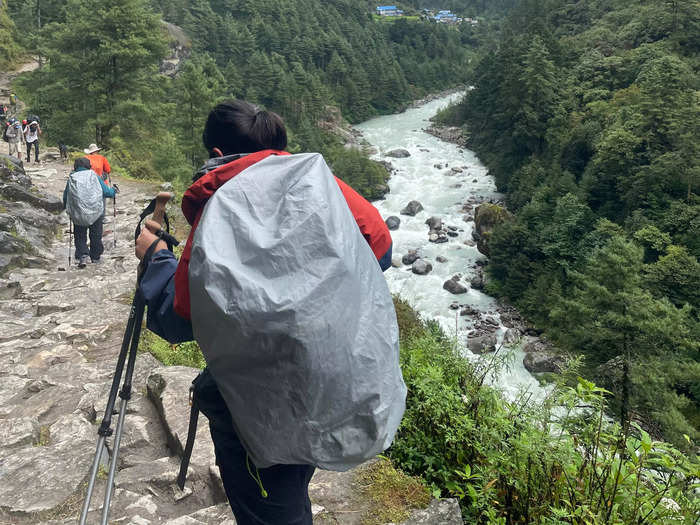
As a Seattleite I'm no stranger to rain, but I'd never bought a proper rain jacket until I started hiking regularly. This Gore-Tex jacket from Outdoor Research was perfect for Everest because it was lightweight and waterproof, and also dried relatively quickly and protected me from the wind chill. I'll definitely get more use out of this jacket at home, and I liked the bright color because it was easy for my family and guide to spot me if I was hiking ahead of them.
To be fully prepared for rain or snow, I used a waterproof backpack cover to cover my day pack so it wouldn't get soaked. I also packed a rain poncho in my backpack for days with heavier downpour, but the rain was never too bad so I was able to get by with my Gore-Tex jacket and backpack cover alone. I usually wore rain paints on days when rain was forecasted, which also kept me warm while hiking at higher elevations.
I stayed hydrated with a filtering water bottle and Liquid IV.
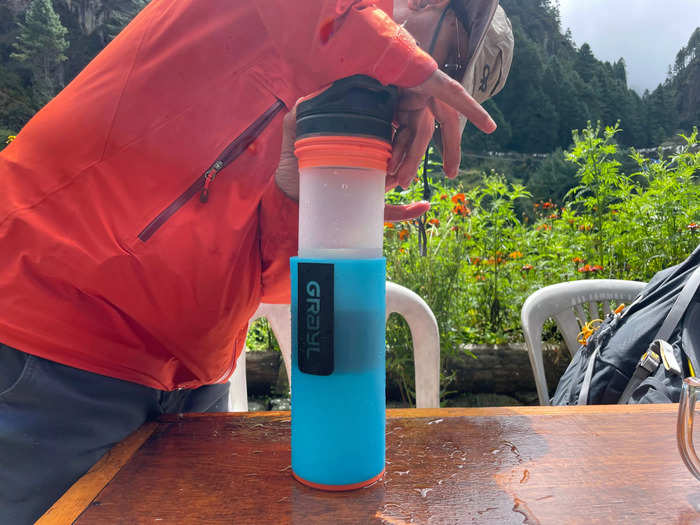
I drank between half a gallon and a full gallon of water each day of the trek to maintain energy and prevent altitude sickness. I stayed hydrated with this water bottle that doubles as a water purifier, and removes most waterborne pathogens, pesticides, and chemicals from tap water.
This bottle proved to be greatly cost effective and helped me limit waste from using plastic water bottles, since I was able to fill it with tap water at the tea houses and restaurants where we ate lunch. I did end up buying bottled water when we got to the last few tea houses and at Base Camp, because our guide said that the tap water may not be safe to drink.
I also brought this liquid IV powder in the tangerine and guava flavors, which I added to my water to ensure I was getting enough electrolytes and help prevent cramps after hours of hiking.
I downloaded a few ebooks on my phone to read during downtime.
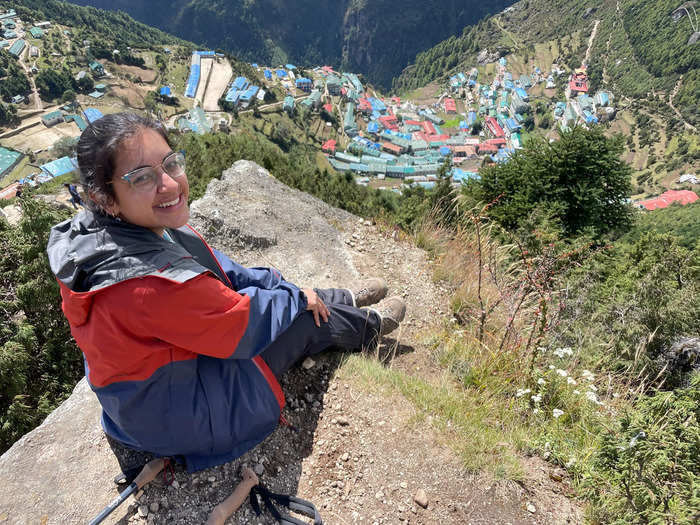
I love reading, and I knew I wanted to bring some new books with me on the trek. Because of the weight limit on duffel bags, I decided to leave behind physical books and stick to e-books that I could read on my phone.
I checked out a few e-books from my library through the Libby app, which kept me busy after dinner and during downtime. I finished one of them, "A Place for Us" by Fatima Farheen Mirza, in just two days, which put me ahead of schedule on my reading goals for the year.
Ultimately, I'm glad I had all the essentials I needed to layer up, stay dry, and enjoy downtime on the trek.
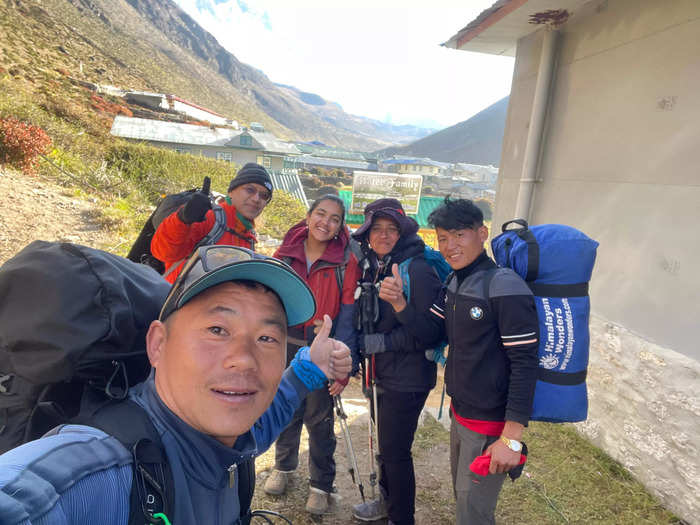
Although I was initially worried about the uncertainty of trekking the Himalayas, having the right supplies for rainy and windy weather gave me peace of mind for whatever we'd encounter. I'm glad that I got to experience this adventure of a lifetime with my family, and I plan to reuse a lot of these items on future treks.
Popular Right Now
Advertisement